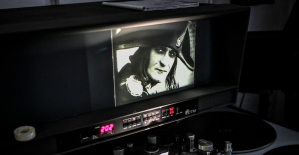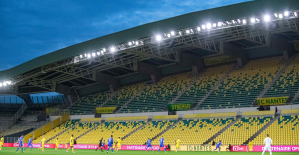Ironically, the best pilot in the USA caused the most expensive aviation accident of all time. And what's more, during a maneuver that was in itself completely superfluous and was only flown to provide impressive images for a promotional film. The damage: around half a billion dollars in 1966 values; Converted to 2023, this means: around 4.65 billion dollars.
It happened about seven kilometers above the Mojave Desert (US state of California). On June 8, 1966 at around 9:30 a.m. local time, test pilot, NASA chief instructor and multiple world record holder Joe Walker at the controls of a Lockheed F-104, the infamous starfighter, collided with the tail unit of the North American XB-70-A Valkyrie experimental bomber .
The single-engine fighter exploded immediately, Walker had no chance. The six-engined bomber lost the port vertical tail, the second on the starboard side was damaged, as were the wings. The Valkyrie flew straight for about 16 seconds, then went into an uncontrolled spin and fell.
The bomber's two pilots ejected. But one of the two, co-pilot Carl Cross, failed the rescue device - he died. And Captain Al White was also seriously injured when the shell-like escape pod automatically closed, but at least survived. A disaster: two dead, one seriously injured, ruinous damage - the development and construction of the two prototypes of the XB-70 had cost more than a billion dollars.
How did the accident happen? Why did a starfighter fly so close to the Valkyrie that it collided? The investigative commission that was quickly formed knew the shockingly banal result: the reason was a promotional film that was to be shot for a US corporation.
General Electric, one of the most important industrial companies in the world, then (and still has) included the aviation division, which manufactures aircraft turbines. In the US there was only one competitor, Pratt
For a new image film, General Electric (GE) wanted dynamic shots of the USAF's most modern flight patterns, which were powered by their own engines. The XB-70, the most modern aircraft of all in the mid-1960s, could not be missing. The Valkyrie was intended to fly in close formation with other GE-powered jets: the single-engine Starfighter, the twin-engine F-4 Phantom heavy fighter and the twin-engine but much smaller F-5 and the T-38 supersonic trainer. The formation flight was filmed and photographed from a sixth aircraft.
The images were spectacular, showing the comparatively huge XB-70 framed by the four much smaller jets. The five aircraft looked like a spearhead in black-and-white photos from above, while color moving images from the bottom left looked even more impressive. Before pictures could be taken from the bottom right, the catastrophe happened.
By June 8, 1966, the Valkyrie had already proven to be a military mistake. Twelve years earlier, the US Department of Defense think tank, the Rand Corporation, had prepared a study on US defense deterrence needs, ie in view of the first nuclear weapons in Soviet hands. The nuclear power of the USA in its day rested on the Boeing B-47 bombers and the soon to be introduced B-52 bombers - both capable of carrying huge weapon loads, but both subsonic.
Since the available high-yield nuclear weapons, especially hydrogen bombs, were still far too big for the first ballistic missiles that were just being developed, the Rand Corporation came to the conclusion that the USA would need a supersonic large bomber in the 1960s - as a future successor to the B-52. The result was USAF Development Requirement #38 in 1955.
The aim was to create a bomber that would combine the speed of the nascent Convair B-58 Hustler with the payload and range of the B-52. Two companies, Boeing and North American Aviation, submitted proposals and received orders for the first phase of development on November 8, 1955. But the result of both companies seemed unsatisfactory to the USAF - a designed take-off weight of 350 tons was illusory. For comparison: The B-52 reached a maximum of 204 tons, the first jumbo jet Boeing 747 in 1969 just 330 tons, and both flew "only" subsonic speed.
Because the shooting down of the US spy plane U-2 over the USSR in 1960 had shown that the Soviets were making huge advances in anti-aircraft missiles, the new US President John F. Kennedy canceled the program at the end of March 1961 - by that time there were already around 800 million dollars spent. During the election campaign, however, the Democrat had assured that he was behind the B-70.
USAF Chief of Staff Curtis LeMay, a self-confessed Kennedy opponent, still wanted the Valkyrie to be fully developed and built, if only to get one over on his enemy in the White House. In January 1962, Secretary of Defense Robert McNamara finally halted development. However, the two prototypes currently under construction should be completed and used as test vehicles: Total costs: two billion dollars. In May 1964 the first XB-70 was ready, in October the second.
The machine was designed as a delta wing with bendable wing tips and slats; the six engines sat side by side in the tail of the fuselage, which converged with the wings. The extremely complicated General Electric Aviation YJ-93 turbines should have powered not only the B-70 but also the long-distance interceptor F-108 Rapier, which had been canceled in 1959 without replacement.
The first prototypes of the XB-70 were still plagued by numerous problems with fuselage construction, landing gear and hydraulics, but all these teething troubles of what was then the world's most complicated aircraft were fixed in the second prototype. The second Valkyrie reached the target speed of Mach 3 for the first time on January 3, 1966 and maintained this speed once for 20 minutes and once even for 32 minutes.
Then came June 8, 1966. The second, "better" Valkyrie was to do General Electric bosses a favor and fly maneuvers with four other GE-powered jets. Suddenly, Joe Walker's F-104 drifted into the XB-70's right wingtip, flipped, and rolled over the Valkyrie's tip. The Starfighter then ripped off the left vertical stabilizer (the right one was also damaged) before exploding the vertical stabilizers and the bomber's left wing.
The accident investigation, which was more of a guesswork based on live film camera footage than a substantive investigation (the debris from the XB-70 and F-104 was so fragmented that little could be discerned from it), concluded that Walker's Starfighter was affected by a Valkyrie's vortex wake was hit and sucked up to her. This phenomenon, which occurs almost exclusively in jet aircraft, was still largely unexplored at the time. According to the commission, Joe Walker had no chance.
The remaining XB-70 remained in use as a NASA experimental vehicle until 1969 and was then retired. It is now in the USAF Museum in Dayton, Ohio. A crater on the moon was named after Joe Walker in 1970; In 2005, he was posthumously awarded the pinnacle of an astronaut for twice flying more than 100 kilometers high in the X-15 rocket plane.
You can also find "World History" on Facebook. We are happy about a like.

 Iran-Israel conflict: what we know about the events of the night after the explosions in Isfahan
Iran-Israel conflict: what we know about the events of the night after the explosions in Isfahan Sydney: Assyrian bishop stabbed, conservative TikToker outspoken on Islam
Sydney: Assyrian bishop stabbed, conservative TikToker outspoken on Islam Torrential rains in Dubai: “The event is so intense that we cannot find analogues in our databases”
Torrential rains in Dubai: “The event is so intense that we cannot find analogues in our databases” Rishi Sunak wants a tobacco-free UK
Rishi Sunak wants a tobacco-free UK Alert on the return of whooping cough, a dangerous respiratory infection for babies
Alert on the return of whooping cough, a dangerous respiratory infection for babies Can relaxation, sophrology and meditation help with insomnia?
Can relaxation, sophrology and meditation help with insomnia? WHO concerned about spread of H5N1 avian flu to new species, including humans
WHO concerned about spread of H5N1 avian flu to new species, including humans New generation mosquito nets prove much more effective against malaria
New generation mosquito nets prove much more effective against malaria The A13 motorway closed in both directions for an “indefinite period” between Paris and Normandy
The A13 motorway closed in both directions for an “indefinite period” between Paris and Normandy The commitment to reduce taxes of 2 billion euros for households “will be kept”, assures Gabriel Attal
The commitment to reduce taxes of 2 billion euros for households “will be kept”, assures Gabriel Attal Unemployment insurance: Gabriel Attal leans more towards a tightening of affiliation conditions
Unemployment insurance: Gabriel Attal leans more towards a tightening of affiliation conditions “Shrinkflation”: soon posters on shelves to alert consumers
“Shrinkflation”: soon posters on shelves to alert consumers The restored first part of Abel Gance's Napoléon presented at Cannes Classics
The restored first part of Abel Gance's Napoléon presented at Cannes Classics Sting and Deep Purple once again on the bill at the next Montreux Jazz Festival
Sting and Deep Purple once again on the bill at the next Montreux Jazz Festival Rachida Dati: one hundred days of Culture on the credo of anti-elitism
Rachida Dati: one hundred days of Culture on the credo of anti-elitism The unbearable wait for Marlène Schiappa’s next masterpiece
The unbearable wait for Marlène Schiappa’s next masterpiece Skoda Kodiaq 2024: a 'beast' plug-in hybrid SUV
Skoda Kodiaq 2024: a 'beast' plug-in hybrid SUV Tesla launches a new Model Y with 600 km of autonomy at a "more accessible price"
Tesla launches a new Model Y with 600 km of autonomy at a "more accessible price" The 10 best-selling cars in March 2024 in Spain: sales fall due to Easter
The 10 best-selling cars in March 2024 in Spain: sales fall due to Easter A private jet company buys more than 100 flying cars
A private jet company buys more than 100 flying cars This is how housing prices have changed in Spain in the last decade
This is how housing prices have changed in Spain in the last decade The home mortgage firm drops 10% in January and interest soars to 3.46%
The home mortgage firm drops 10% in January and interest soars to 3.46% The jewel of the Rocío de Nagüeles urbanization: a dream villa in Marbella
The jewel of the Rocío de Nagüeles urbanization: a dream villa in Marbella Rental prices grow by 7.3% in February: where does it go up and where does it go down?
Rental prices grow by 7.3% in February: where does it go up and where does it go down? With the promise of a “real burst of authority”, Gabriel Attal provokes the ire of the opposition
With the promise of a “real burst of authority”, Gabriel Attal provokes the ire of the opposition Europeans: the schedule of debates to follow between now and June 9
Europeans: the schedule of debates to follow between now and June 9 Europeans: “In France, there is a left and there is a right,” assures Bellamy
Europeans: “In France, there is a left and there is a right,” assures Bellamy During the night of the economy, the right points out the budgetary flaws of the macronie
During the night of the economy, the right points out the budgetary flaws of the macronie These French cities that will boycott the World Cup in Qatar
These French cities that will boycott the World Cup in Qatar Champions League: France out of the race for 5th qualifying place
Champions League: France out of the race for 5th qualifying place Ligue 1: at what time and on which channel to watch Nantes-Rennes?
Ligue 1: at what time and on which channel to watch Nantes-Rennes? Marseille-Benfica: 2.99 million viewers watching OM’s victory on M6
Marseille-Benfica: 2.99 million viewers watching OM’s victory on M6 Cycling: Cofidis continues its professional adventure until 2028
Cycling: Cofidis continues its professional adventure until 2028


















